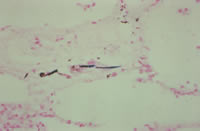|
|
Agency for Toxic Substances and Disease Registry
Case Studies in Environmental Medicine (CSEM)
Asbestos Toxicity
What Is the Biological Fate of Asbestos?
|
Upon completion of this section, you should be able to
- identify where asbestos fibers are most likely to be retained in the body
|
|
Inhaled asbestos fibers enter the upper and lower respiratory tracts. The durability of the fibers in lung tissue may lead to a risk of disease.
|
|
Some of the inhaled asbestos fibers are deposited on the surface of the larger airways where some of them are cleared by mucociliary transport and swallowing. Other fibers are deposited further in the lung, especially in the bifurcations of the tracheobronchial tree and, eventually, in the alveolar sacs (Broaddus 2001).
The dimensions of the asbestos fiber determines how easily and how far it penetrates the lungs and how quickly it is cleared. Wide fibers (diameter greater than 2 to 5 microns) tend to be deposited in the upper respiratory tract and cleared. Long thin asbestos fibers reach the lower airways and alveoli and tend to be retained in the lungs. However, it is important to remember that asbestos fibers of all lengths can induce pathological changes and cannot be excluded as contributors to asbestos-related diseases (Dodson et al. 2003).
|
|
In the lungs, asbestos fibers are subject to several lung defenses.
- Mucociliary transport of the larger airways. This cleared material is usually swallowed and eliminated.
- Dissolution by alveolar macrophages.
- Attempted phagocytosis, resulting in fragmentation and splitting of fibers.
- Encapsulation by proteins and deposition in ferrous material in a drumstick configuration called a ferruginous or asbestos body.
The lymphatic system also clears fibers from the lungs (Dodson et al. 2003).
Although some asbestos fibers are cleared from the lungs, most are retained in lung tissue for many years. The total burden of fibers in the lungs depends not only the size of the fiber but the amount of fibers inhaled from the environment (Dodson et al. 2003).

|
|
From the lungs, some asbestos fibers (mainly short fibers) can migrate to pleural and peritoneal spaces, especially following patterns of lymphatic drainage (Broaddus 2001). Their presence in the peritoneum is more likely if there is a high fiber burden in the lungs.
|
|
How rapidly the body’s defenses can clear asbestos fibers from the lungs depends in part on the type of asbestos. Amphibole fibers are retained longer than serpentine fibers of the same dimensions (Hillerdal 1999). Even so, all types of fibers are retained for many years in the lungs (2001a).
|
|
Most ingested asbestos fibers pass through the gastrointestinal tract unchanged and are cleared in the feces. A few ingested fibers pass through the walls of the gastrointestinal tract. Some of these fibers stay in the peritoneal cavity. Other of these fibers move into the bloodstream and into the kidneys, where some are eliminated unchanged in the urine.
|
|
- Some inhaled asbestos fibers reach the lungs, where they become lodged in lung tissue, especially in the lower lung fields.
- Some fibers are encapsulated in asbestos bodies.
Some fibers move to pleural or peritoneal spaces or the mesothelium.
- The half-lives of fibers vary, but they are retained for many years.
- Ingested asbestos fibers are usually eliminated from the body.
|
Previous Section
Next Section
|




